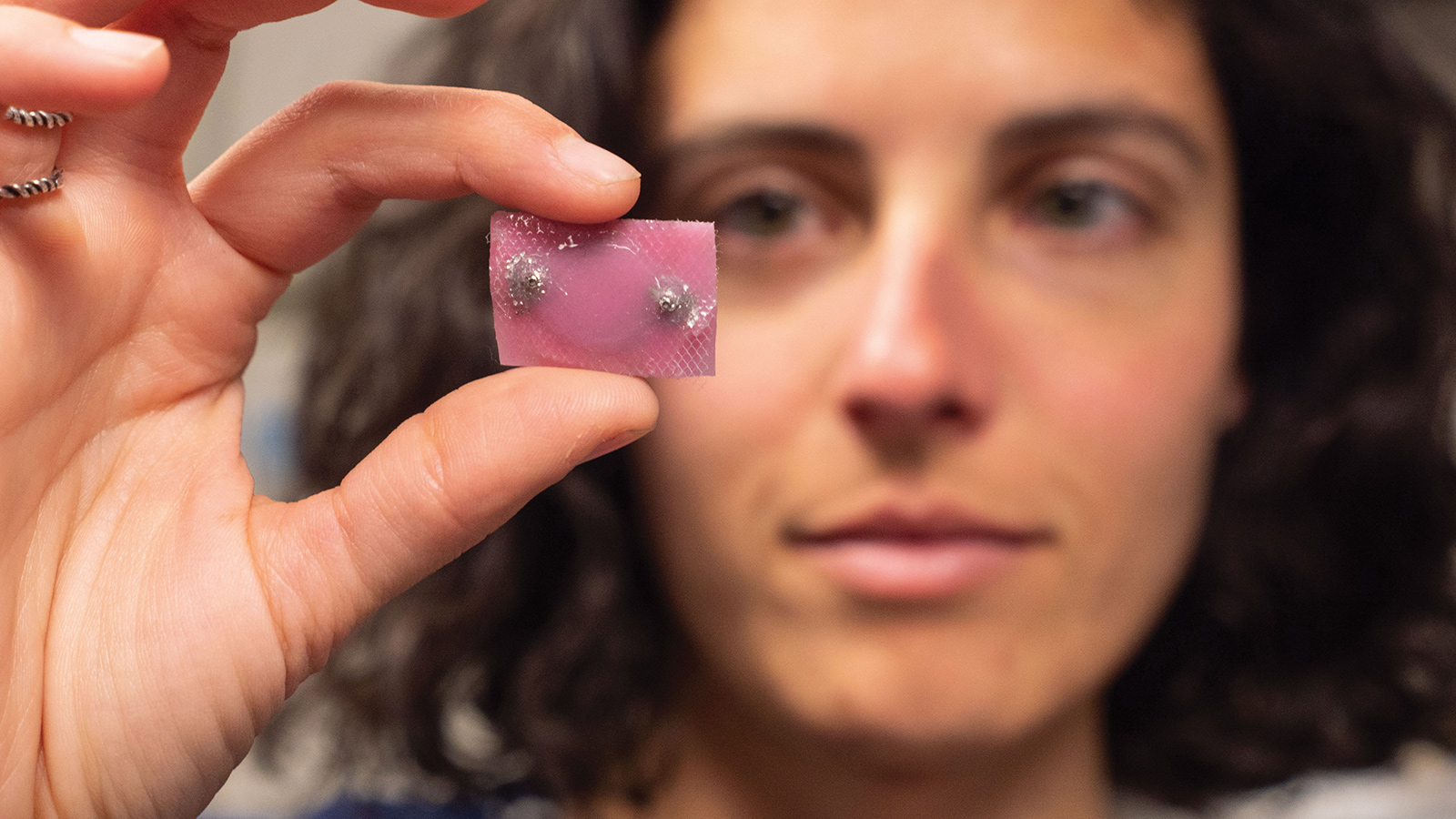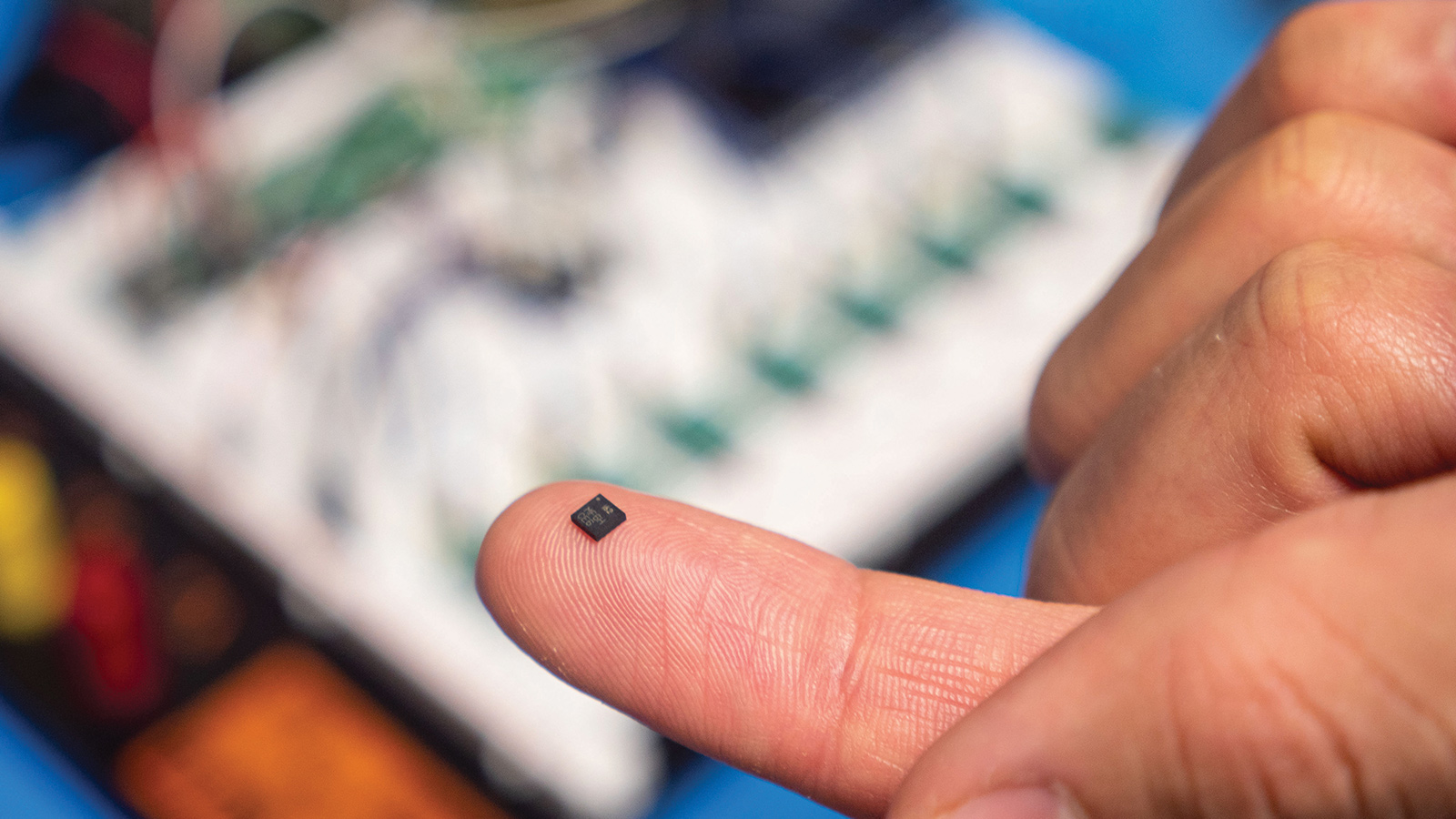Stay Up to Date
Submit your email address to receive the latest industry and Aerospace America news.
U.S. astronauts on the moon or Mars will need a spacesuit that won’t injure or exhaust them. One hurdle is that no one knows exactly what goes on in a physical sense when an astronaut inside one of today’s spacesuits moves his or her limbs. Amanda Miller visited with student researchers in Colorado who think they know how to find the sore spots in today’s suits, a breakthrough that could point the way to better designs, perhaps including one of their own.
In a windowless, subterranean lab at the University of Colorado in Boulder, doctoral candidate Katya Arquilla takes what looks like the sleeve of a shirt down from a shelf and shows it to me. It’s black and made from a stretchy fabric, with fine copper wire connecting patches of pink plastic. This is just a mock-up, but ultimately, she and fellow students plan to create an entire skin-tight body suit with these pink pressure sensors arrayed over it. When the wearer rubs or bumps against something, or something rubs or bumps against the wearer, the resulting pressure increases electrical resistance in the copper wires, and the suit detects the contact.
The team plans to create a second suit and equip it with smartphone-inspired inertial sensors to track the wearer’s limb movements.
If all goes as planned, test subjects will don these suits separately, each a skin-tight layer under a conventional spacesuit. The researchers will begin to diagnose where and why today’s spacesuits are rubbing astronauts the wrong way. The suit with the inertial sensors should be ready first, in about a year.
Taken together, the findings could help the Colorado team or others design a less bulky spacesuit that won’t injure or unduly tire astronauts working on the surface of Mars, where astronauts will endure long shifts. The students don’t think they could have a suit ready for NASA’s return to the moon, planned for 2024.
To understand the problem, consider that conventional spacesuits are pressurized with filtered oxygen that the wearer breathes, including the gas that flows through his or her gloves. This results in a suit that’s hard to move around in. Improvements to the suits over the years haven’t solved a major problem: “The astronauts are getting injured,” says Allison Anderson, who oversees the spacesuit research as an aerospace biomedical engineer and bioastronautics assistant professor.
Some astronauts have lost fingernails from squeezing their gloves so much. Others have suffered shoulder injuries. There are also aggravations, such as pressure “hot spots” and fatigue.
Work will be especially difficult on Mars, where the astronauts could be expected to go outside once a week for eight-hour shifts: “That’s a huge increase in the amount of EVA [extravehicular activity] compared to what we’re doing now, where it’s a relatively infrequent event,” Anderson says. She thinks suit-induced strain and injuries will rise with the added demands.
The root of the problem is that today’s suits require astronauts to struggle against appendages that become rigid under pressurization. Once manipulated, these parts naturally want to revert to their original shapes.
As experts in the emerging field of bioastronautics, Anderson and her students set out to measure the strain on the wearers and conceive of a less cumbersome spacesuit design. They think the answer could lie in a hybrid that will combine a stretchy, skin-squeezing layer (probably neoprene) under a slimmer version of today’s gas-pressurized suits.
Together, the layers must impart sufficient, even pressure across the wearer’s body, just as today’s suits do. That’s crucial for functions like blood flow and to avoid outright calamity.
“You need to be above the vaporization pressure of water to make sure the water in the surface layer of your skin doesn’t boil,” Anderson explains. “Even above that, you need a level of pressure to allow oxygen to dissolve into your bloodstream. Above that, we like to have higher pressures because it preserves us from getting decompression sickness.”
Anderson thinks aspects of the research have a chance of being incorporated into a future suit that would be made by a commercial manufacturer. Her team’s dream come true, of course, would be to make an entirely new suit. At the moment, the students are working on the suit to meet academic requirements, with funds from the university.
Gas-pressurized layer
Today, an astronaut taking a spacewalk outside the International Space Station does so within a double-walled, gas-inflated suit. An inner bladder holds the gas that’s imparting the pressure on the body — while a tough, outer fabric layer, called a restraint layer, stops the bladder from expanding too big from the gas’ pressure and helps protect the occupant from the cold, radiation and debris of space.
But no one really knows how the wearer’s limbs move relative to the wall of the suit. That’s the first thing the students want to know before they design a suit.
The schedule is not firm, but in about a year, a test subject will wear the inertial suit under a conventional spacesuit. Doctoral candidate Young-Young Shen will track the movements of the subject’s limbs compared to the movements of the spacesuit.
Shen likens the sensing process partly to what happens inside a smartphone. “It knows which way the phone is tilted,” he says. Likewise, “you can figure out which way a certain limb segment is tilted,” says Shen, who leads the work on a set of inertia sensors with a particular emphasis on tracking joint angles.
While the sensors track the subject’s movements on the inside, cameras will simultaneously record the suit’s movements from the outside.
“That gives us an idea of how they’re positioned relative to the suit, how they’re moving relative to the suit, what parts of the suit they’re coming into contact with,” Shen says.
The students suspect that a test subject’s movements and the movements of the suit will look nothing alike.
Meanwhile, Arquilla is working on the pressure sensors that will measure the force of astronauts bumping into the sidewalls of the suit, and in that way, quantify likelihood of injury.
A conventional spacesuit “is like this big bubble around your arm, and because it doesn’t fit you perfectly, and it’s bigger than your arm actually is, to move, say, something over here, you have to get the suit to move, and then move over to where you want to do something,” Arquilla says.
Arquilla and fellow doctoral candidate Abhishektha Boppana have built a partial prototype of wearable contact sensors — the copper-sewn sleeve. They molded channels in thumbprint-sized dabs of flexible plastic — soft, to conform with body contours — and filled the channels with liquid metal, feeding an electric current through the wire stitching to the metal.
“When we press down on those channels, the liquid changes shape, and that creates a change in [electrical] resistance that we can measure,” Boppana says. “We correlated that to a change in the amount of force that’s being applied over that area.”
Mechanical-counterpressure layer
The gas in today’s oxygen-filled spacesuits must be cranked up to a pressure equivalent of about a third of Earth’s atmosphere. Adding the skin-tight inside layer — a suit concept called mechanical counterpressure — means the hybrid suit would require less gas pressure, so the suit could be less bulky.
Having stretched out several fabrics on a materials strength testing machine, Anderson and her team think that with the stretchy fabric neoprene, which wet suits are made from, they can get to about half the required one-third of the atmosphere.
There is another challenge, though. A conventional suit, despite its shortcomings, does a good job of spreading pressure evenly with its layer of oxygen. The Colorado team needs to impart pressure evenly, too, with their suit. “A mechanical-counterpressure suit needs to fit exactly to the contours of your body,” says aerospace engineering master’s student Roger Huerta.
An astronaut’s hands posed a big issue for the team. Huerta has made a prototype of plastic inserts that would be tucked inside the wearer’s gloves to fit an individual’s concave palm. The whole thing is snugged on with a gauntlet that can be tightened.
The boot
Boppana, who took part in the sensor research, is also studying how to make a snug enough boot, taking cues from researchers at NASA’s Johnson Space Center in Texas who started studying ideas for a Mars spacesuit and ran into trouble on the march.
“They realized that when they were starting to walk, the boot would sort of just stay on the ground, and their heel would lift up out of it,” Boppana says. “And that’s due to the suit just being so heavy that the boot is supporting a good portion of that weight.”
He’s now making a 3D model of how a person’s foot changes shape throughout a walking gait to engineer a boot — complete with both mechanical-counterpressure and gas-pressurized layers — from the inside out.
A boot for walking on another world, with significant gravity, will be a first.
“On the moon, you’re not really walking, you’re loping,” Boppana says. “As long as you can push off a little bit, you have locomotion. But when we go to a higher-gravity environment such as Mars, you really need the same type of locomotion we have here on Earth.”
About Amanda Miller
Amanda is a freelance reporter and editor based near Denver with 20 years of experience at weekly and daily publications.
Related Posts
Stay Up to Date
Submit your email address to receive the latest industry and Aerospace America news.








